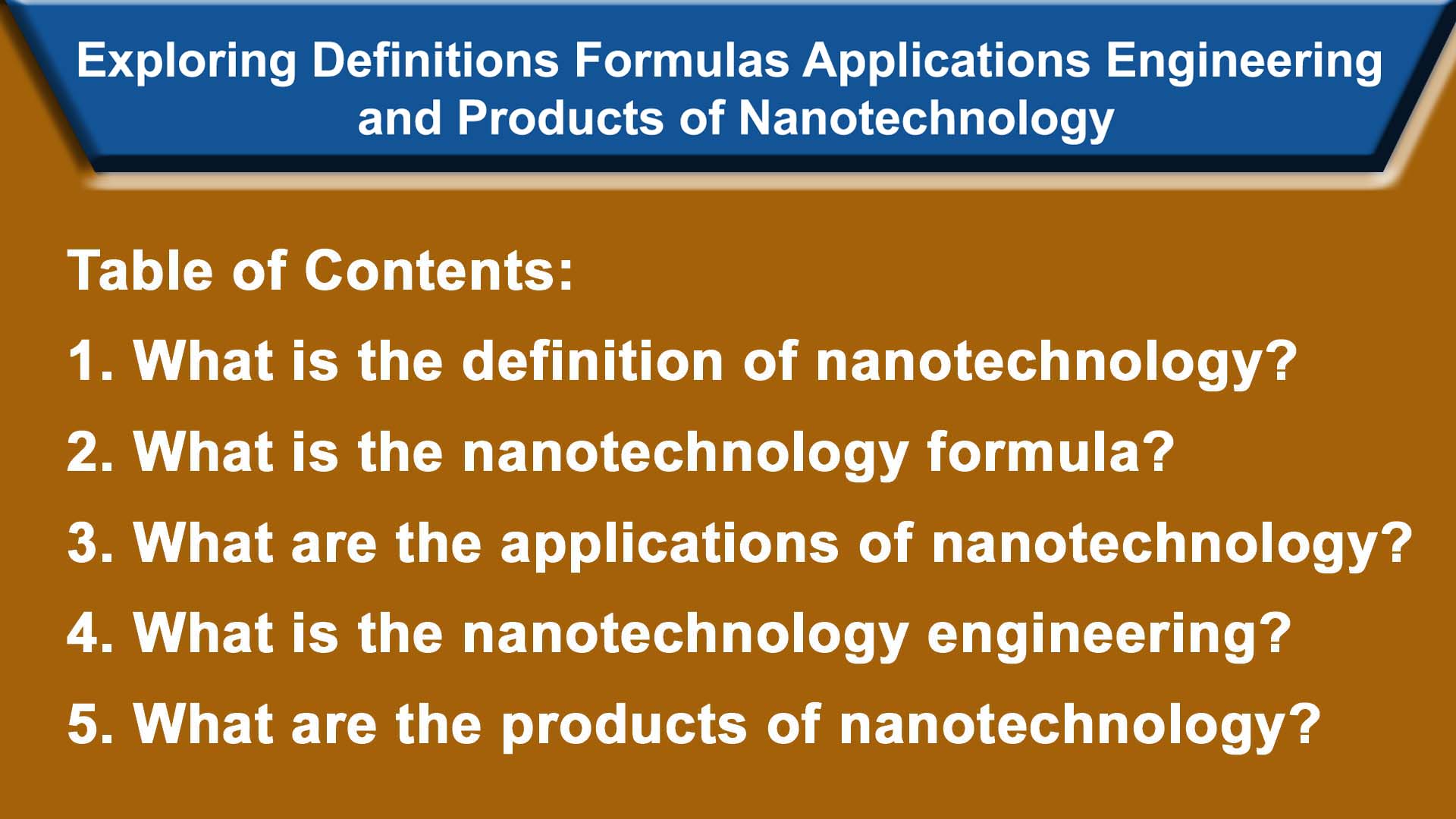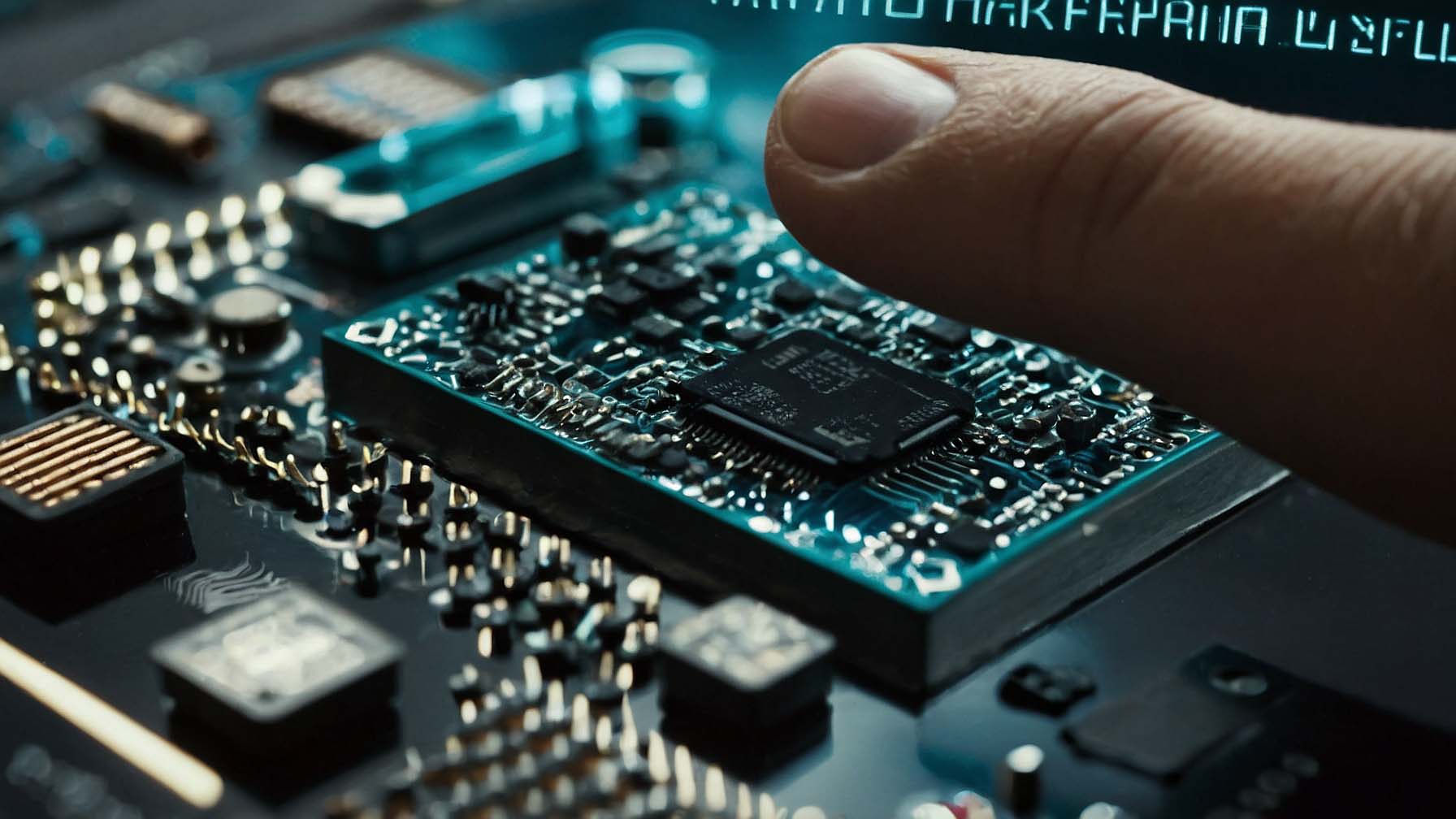

 Exploring Definitions Formulas Applications Engineering and Products of Nanotechnology
Exploring Definitions Formulas Applications Engineering and Products of Nanotechnology
A Comprehensive Journey into the World of Nanotechnology, from Fundamental
Concepts to Cutting-edge Applications and Engineering Innovations
Nanotechnology involves manipulating matter at the Nano scale, typically at dimensions of 1 to 100 nanometers. It explores the unique properties materials exhibit at this scale to create innovative products and technologies. Applications span medicine, electronics, energy, and more. Precision at the atomic and molecular levels offers groundbreaking advancements, revolutionizing various industries.
TABLE OF CONTENTS
1. What is the definition of nanotechnology?
2. What is the nanotechnology formula?
3. What are the applications of nanotechnology?
4. What is the nanotechnology engineering?
5. What are the products of nanotechnology?
1. What is the definition of nanotechnology?
Nanotechnology is a branch of science and technology that involves manipulating matter on an extremely small scale, typically at the nanometer level. A nanometer is one billionth of a meter. Nanotechnology focuses on understanding, controlling, and manipulating materials and devices at the Nano scale, which is the scale of individual atoms and molecules.
The field of nanotechnology spans various disciplines, including physics, chemistry, and biology, engineering, and materials science. It aims to create and utilize materials, devices, and systems with unique properties and functionalities that emerge at the Nano scale. This may involve manipulating and engineering structures at the atomic or molecular level to achieve specific properties or functions.
Nanotechnology has a wide range of potential applications, including in medicine, electronics, energy, materials science, and environmental science. It holds the promise of creating new materials with enhanced properties, more efficient and targeted drug delivery systems, smaller and more powerful electronic devices, and other innovative solutions across various industries.
Nano Technology doesn’t have a single formula, as it encompasses a broad range of techniques and applications. However, one fundamental aspect involves manipulating materials at the Nano scale, typically 1 to 100 nanometers. This may involve various methods such as top-down or bottom-up approaches, including molecular self-assembly, lithography, and other nano fabrication techniques. The specific processes and materials depend on the intended application within nanotechnology.
2. What is the nanotechnology formula?
Nanotechnology doesn’t have a single formula, as it encompasses a broad range of techniques and applications. However, one fundamental aspect involves manipulating materials at the Nano scale, typically 1 to 100 nanometers. This may involve various methods such as top-down or bottom-up approaches, including molecular self-assembly, lithography, and other nanofabrication techniques. The specific processes and materials depend on the intended application within nanotechnology.

Nano Technology Image
3. What are the applications of nanotechnology?
Nanotechnology has a wide range of applications across various fields, and its potential impact on technology, medicine, energy, materials science, and electronics is significant. Here are some notable applications of nanotechnology:
1. Medicine:
• Drug Delivery: Nanoparticles can be designed to deliver drugs directly to targeted cells or tissues, improving the effectiveness of treatments while minimizing side effects.
• Diagnostic Tools: Nano scale materials enable the development of highly sensitive diagnostic tools for early detection of diseases.
• Therapeutics: Nano scale materials can be used for innovative therapeutic interventions, such as cancer treatments and regenerative medicine.
2. Electronics:
• Nano electronics: Nano scale materials are used to create smaller and more efficient electronic components, leading to advancements in computing power and energy efficiency.
• Quantum Dots: These Nano scale semiconductor particles have applications in displays, imaging technologies, and solar cells.
3. Materials Science:
• Nanostructured Materials: Nanotechnology allows the creation of materials with enhanced properties, such as increased strength, improved conductivity, and greater durability.
• Smart Materials: Nano materials can be engineered to respond to external stimuli, leading to the development of smart materials with applications in sensors and actuators.
4. Energy:
• Solar Cells: Nanotechnology contributes to the development of more efficient and cost-effective solar cells by improving light absorption and electron transport.
• Energy Storage: Nano materials are used in the development of advanced batteries and super capacitors for energy storage.
5. Environmental Remediation:
• Water Purification: Nano materials are employed in water treatment processes for removing pollutants and contaminants.
• Air Filtration: Nanotechnology is used to develop efficient air filters that can capture and neutralize harmful particles.
6. Textiles:
• Stain Resistance: Nano coatings can be applied to textiles to make them water-repellent and resistant to stains.
• Antibacterial Fabrics: Nanoparticles can be integrated into fabrics to impart antibacterial properties, reducing the growth of bacteria and odors.
7. Food and Agriculture:
• Food Packaging: Nanotechnology is used to develop antimicrobial and barrier coatings for food packaging to extend shelf life.
• Precision Agriculture: Nano sensors can be employed for monitoring soil conditions and crop health.
8. Cosmetics:
• Sunscreen: Nanoparticles in sunscreens provide transparent protection without the white residue associated with traditional formulations.
• Anti-aging Products: Nanotechnology is used in the development of cosmetics with ingredients that can penetrate the skin more effectively.
It’s important to note that while nanotechnology offers numerous benefits, ethical and safety considerations are crucial in its development and application. Researchers and policymakers continue to assess and address potential risks associated with Nano materials.

Nano Technology for Amazing Future World
4. What is the nanotechnology engineering?
Nanotechnology engineering is a multidisciplinary field of science and engineering that focuses on manipulating matter at the Nano scale, which is typically in the range of 1 to 100 nanometers. A nanometer is one billionth of a meter. At this scale, the properties of materials can differ significantly from those at the macro scale, leading to unique and often enhanced physical, chemical, and biological characteristics.
Nanotechnology engineering involves the design, fabrication, characterization, and application of materials, devices, and systems with Nano scale dimensions. It spans various scientific disciplines, including physics, chemistry, biology, materials science, and engineering.
Key aspects of nanotechnology engineering include:
1. Nano materials: Developing and understanding materials at the Nano scale, such as nanoparticles, nanotubes, and Nano composites.
2. Nano devices: Creating functional devices and systems with components at the Nano scale, which can have applications in electronics, sensors, medicine, and more.
3. Nanofabrication: Employing techniques to manufacture structures and devices at the Nano scale, including top-down and bottom-up approaches.
4. Characterization: Studying and analyzing materials and structures at the Nano scale using various tools and techniques like scanning electron microscopy, atomic force microscopy, and spectroscopy.
5. Applications: Applying nanotechnology in various fields, such as medicine (Nano medicine), electronics, energy, environmental science, and information technology.
Nanotechnology has the potential to revolutionize many industries by offering new and improved materials, devices, and technologies. However, it also raises ethical and safety concerns that researchers and policymakers need to address as the technology advances.
5. What are the products of nanotechnology?
Nanotechnology has led to the development of a wide range of products across various industries. Some notable products of nanotechnology include:
1. Nano Medicine: Nanotechnology has revolutionized medicine with the development of targeted drug delivery systems, diagnostic tools, and imaging agents at the Nano scale. Examples include nanoparticles for cancer therapy, Nano scale drug carriers, and contrast agents for medical imaging.
2. Sunscreen and Cosmetics: Nanoparticles such as titanium dioxide and zinc oxide are used in sunscreens and cosmetics for their ability to provide effective UV protection without leaving a visible residue.
3. Electronics: Nanotechnology has significantly contributed to the miniaturization of electronic components, leading to the development of smaller and more powerful devices. Nano scale materials are used in transistors, memory devices, and conductive inks.
4. Textiles: Nanotechnology has been applied to create fabrics with enhanced properties, such as water resistance, stain resistance, and antibacterial properties. Nanoparticles are often used to impart these characteristics to textiles.
5. Food and Agriculture: Nanotechnology is employed in the food industry for packaging materials with improved barrier properties, food additives with enhanced nutritional value, and delivery systems for controlled release of nutrients or pesticides in agriculture.
6. Energy Storage: Nano materials are utilized in the development of advanced batteries and super capacitors, enhancing energy storage capacity and efficiency.
7. Water Purification: Nanotechnology is employed in the creation of advanced water purification systems, using Nano materials like carbon nanotubes or nanoparticles to remove contaminants from water.
8. Coatings and Surface Treatments: Nano coatings are used to provide materials with improved durability, scratch resistance, and other desirable properties. They find applications in automotive, aerospace, and various industrial sectors.
9. Sports Equipment: Nano materials are used in the manufacturing of sports equipment like tennis rackets, golf clubs, and bicycles to enhance strength, flexibility, and performance.
10. Environmental Remediation: Nanotechnology is being explored for applications in environmental cleanup, such as the removal of pollutants and contaminants from soil and water.
It’s important to note that the field of nanotechnology is continually evolving, and ongoing research may lead to the development of new and innovative products in the future.